-
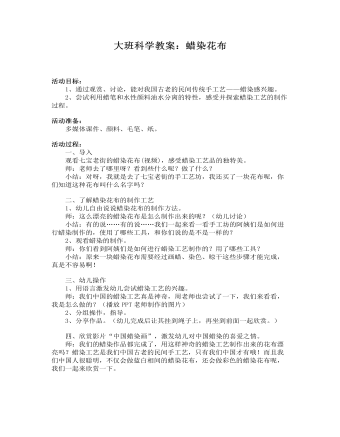
大班科学教案:蜡染花布
活动准备: 多媒体课件、颜料、毛笔、纸。活动过程: 一、导入 观看七宝老街的蜡染花布(视频),感受蜡染工艺品的独特美。 师:老师去了哪里呀?看到些什么呢?做了什么? 小结:对呀,我就是去了七宝老街的手工艺坊,我还买了一块花布呢,你们知道这种花布叫什么名字吗? 二、了解蜡染花布的制作工艺 1、幼儿自由说说蜡染花布的制作方法。 师:这么漂亮的蜡染花布是怎么制作出来的呢?(幼儿讨论) 小结:有的说……有的说……我们一起来看一看手工坊的阿姨们是如何进行蜡染制作的,使用了哪些工具,和你们说的是不是一样的? 2、观看蜡染的制作。 师:你们看到阿姨们是如何进行蜡染工艺制作的?用了哪些工具? 小结:原来一块蜡染花布需要经过画蜡、染色、晾干这些步骤才能完成,真是不容易啊!
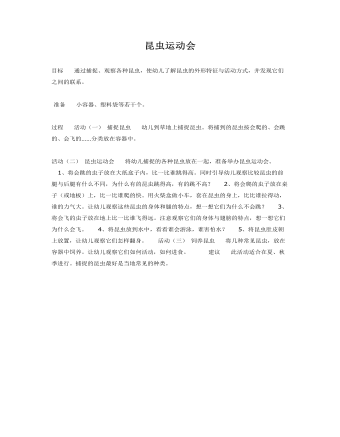
大班科学教案:昆虫运动会
准备 小容器、塑料袋等若干个。 过程 活动(一)捕捉昆虫 幼儿到草地上捕捉昆虫。将捕到的昆虫按会爬的、会跳的、会飞的……分类放在容器中。 活动(二)昆虫运动会 将幼儿捕捉的各种昆虫放在一起,准备举办昆虫运动会。 1、将会跳的虫子放在大纸盒子内,比一比谁跳得高。同时引导幼儿观察比较昆虫的前腿与后腿有什么不同,为什么有的昆虫跳得高,有的跳不高?
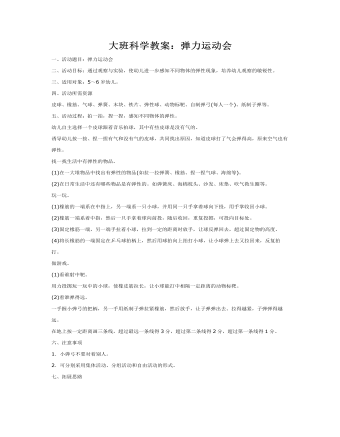
大班科学教案:弹力运动会
二、活动目标:通过观察与实验,使幼儿进一步感知不同物体的弹性现象,培养幼儿观察的敏锐性。三、适用对象:5~6岁幼儿。四、活动所需资源皮球、橡筋、气球、弹簧、木块、铁片、弹性球、动物标靶、自制弹弓(每人一个)、纸制子弹等。五、活动过程:拍一拍,捏一捏,感知不同物体的弹性。幼儿自主选择一个皮球跟着音乐拍球,其中有些皮球是没有气的。诱导幼儿按一按、捏一捏有气和没有气的皮球,共同找出原因,知道皮球打了气会弹得高,原来空气也有弹性。找一找生活中有弹性的物品。(1)在一大堆物品中找出有弹性的物品(如拉一拉弹簧、橡筋、捏一捏气球、海绵等)。(2)在日常生活中还有哪些物品是有弹性的。如弹簧床、海棉枕头、沙发、床垫、吹气救生圈等。玩一玩。(1)橡筋的一端系在中指上,另一端系一只小球,并用同一只手拿着球向下投,用手掌收回小球。(2)橡筋一端系着中指,然后一只手拿着球向前投,随后收回,重复投掷,可投向目标处。(3)固定橡筋一端,另一端手拉着小球,拉到一定的距离时放手,让球反弹回去,超过固定物的高度。(4)将长橡筋的一端固定在乒乓球拍柄上,然后用球拍向上拍打小球,让小球弹上去又拉回来,反复拍打。做游戏。
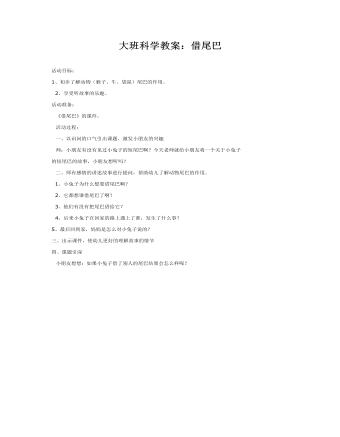
大班科学教案:借尾巴
2、享受听故事的乐趣。活动准备: 《借尾巴》的课件。 活动过程: 一、以讯问的口气引出课题,激发小朋友的兴趣 师:小朋友有没有见过小兔子的短尾巴啊?今天老师就给小朋友将一个关于小兔子的短尾巴的故事,小朋友想听吗? 二、师有感情的讲述故事进行提问,帮助幼儿了解动物尾巴的作用。 1、小兔子为什么想要借尾巴啊?
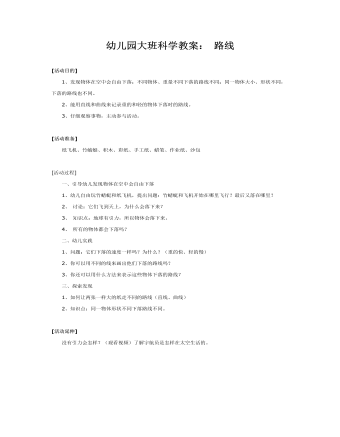
幼儿园大班科学教案: 路线
[活动准备] 纸飞机、竹蜻蜓、积木、彩纸、手工纸、蜡笔、作业纸、沙包 [活动过程] 一、引导幼儿发现物体在空中会自由下落1、幼儿自由玩竹蜻蜓和纸飞机,提出问题:竹蜻蜓和飞机开始在哪里飞行?最后又落在哪里?2、讨论:它们飞到天上,为什么会落下来?3、知识点:地球有引力,所以物体会落下来。4、所有的物体都会下落吗?

小班科学教案 挖土大力士
【活动准备】1、活动开展前教师和家长应带幼儿观察建筑工地。2、准备各种挖土工具的图书、图片、录像等资料。3、收集玩具挖土机。 【活动过程】1、导入:小朋友,你们见过挖土机吗?谁能说一说挖土机有什么本领?2、观看录象:在各种不同场所工作着的挖土机。 (1)请幼儿仔细观察挖土机是怎样工作的。 (2)请幼儿观察挖土机用什么挖土?像什么? (3)让幼儿学着挖土机按顺序作挖土的动作。 (4)引导幼儿用语言描述挖土机的样子以及它挖土的动作。
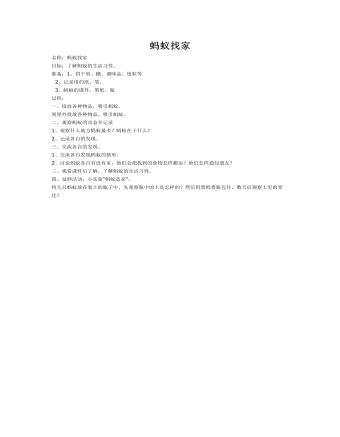
大班科学教案:蚂蚁找家
过程: 一、投放各种物品,吸引蚂蚁。 到屋外投放各种物品,吸引蚂蚁。 二、观察蚂蚁的动态并记录 1、观察什么地方蚂蚁最多?蚂蚁在干什么? 2、记录各自的发现。 三、交流各自的发现。 1、交流各自发现蚂蚁的情形。 2、讨论蚂蚁各自有没有家,他们会把找到的食物怎样搬运?他们怎样通知朋友?
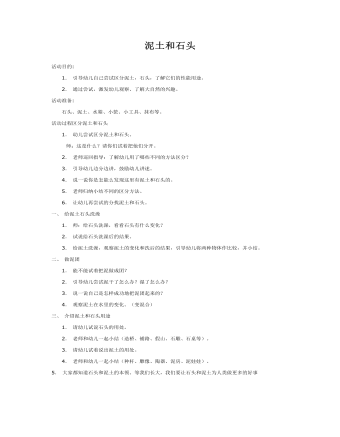
大班科学教案:泥土和石头
1.幼儿尝试区分泥土和石头。 师:这是什么?请你们试着把他们分开。 2.老师巡回指导:了解幼儿用了哪些不同的方法区分? 3.引导幼儿边分边讲,鼓励幼儿讲述。 4.说一说你是怎能么发现这里有泥土和石头的。 5.老师归纳小结不同的区分方法。 6.让幼儿再尝试的分找泥土和石头。 一、给泥土石头洗澡 1.师:给石头洗澡,看看石头有什么变化? 2.试说给石头洗澡后的结果。 3.给泥土洗澡,观察泥土的变化和洗后的结果,引导幼儿将两种物体作比较,并小结。
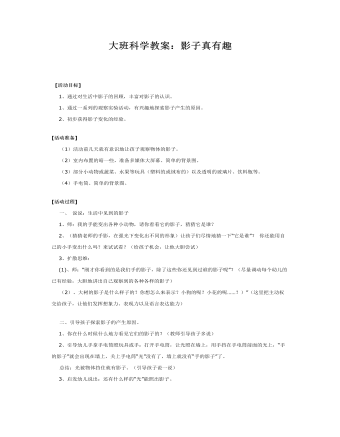
大班科学教案:影子真有趣
[活动准备] (1)活动前几天就有意识地让孩子观察物体的影子。 (2)室内布置的暗一些,准备多媒体大屏幕、简单的背景图。 (3)部分小动物或蔬菜、水果等玩具(塑料的或绒布的)以及透明的玻璃片、饮料瓶等。 (4)手电筒、简单的背景图。[活动过程] 一、说说:生活中见到的影子 1、师:我的手能变出各种小动物,请你看着它的影子,猜猜它是谁? 2、(猜猜老师的手影,在强光下变化出不同的形象)让孩子们尽情地猜一下“它是谁”?你还能用自己的小手变出什么吗?来试试看?(给孩子机会,让他大胆尝试) 3、扩散思维: (1)、师:“刚才你看到的是我们手的影子,除了这些你还见到过谁的影子呢”?(尽量调动每个幼儿的已有经验,大胆地讲出自己观察到的各种各样的影子) (2)、大树的影子是什么样子的?你想怎么来表示?小狗的呢?小花的呢……?)”(这里把主动权交给孩子,让他们发挥想象力、表现力以及语言表达能力)
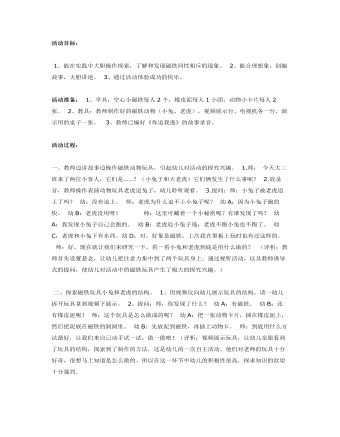
大班科学教案:你追我逃
活动过程: 一、教师边讲故事边操作磁铁动物玩具,引起幼儿对活动的探究兴趣。 1.师:今天大二班来了两位小客人,它们是……?(小兔子和大老虎)它们俩发生了什么事呢? 2.放录音,教师操作表演动物玩具老虎追兔子,幼儿聆听观看。 3.提问:师:小兔子被老虎追上了吗? 幼:没有追上。 师:老虎为什么追不上小兔子呢? 幼A:因为小兔子跑的快。 幼B:老虎没用呀! 师:这里可藏着一个小秘密呢?有谁发现了吗? 幼A:我发现小兔子自己会跑的。 幼B:老虎追小兔子逃,老虎不跑小兔也不跑了。 幼C:老虎和小兔下有东西。幼D:对,好象是磁铁,上次我在黑板上玩时也有过这样的。 师:好,现在就让我们来研究一下,看一看小兔和老虎到底是用什么做的? (评析:教师首先设置悬念,让幼儿把注意力集中到了两个玩具身上。通过视听活动,以及教师诱导式的提问,使幼儿对活动中的磁铁玩具产生了极大的探究兴趣。) 二、探索磁铁玩具小兔和老虎的结构。 1、用视频仪向幼儿展示玩具的结构。请一幼儿拆开玩具拿到视频下展示。 2、提问:师:你发现了什么? 幼A:有磁铁。 幼B:还有橡皮泥呢! 师:这个玩具是怎么做成的呢? 幼A:把一张动物卡片,插在橡皮泥上,然后把泥嵌在磁铁的洞洞里。 幼B:先放泥到磁铁,再插上动物卡。 师:到底用什么方法最好,让我们来自己动手试一试,做一做吧!(评析:视频展示玩具,让幼儿亲眼看到了玩具的结构,探索到了制作的方法,这是幼儿的一次自主活动。他们对老师的玩具十分好奇,很想马上知道是怎么做的。所以在这一环节中幼儿的积极性很高,探求知识的欲望十分强烈。 三、幼儿大胆操作探索制作磁铁玩具。 1、师:老师已经给你们准备好了制作需要的材料,小朋友可以自己动手做两个玩具,做好后可以玩一玩两个动物你追我逃的游戏。2、幼儿动手操作,教师巡回观察和适当指导幼儿制作,鼓励幼儿遇到困难自己想办法解决。 师:动动脑筋,想想办法,怎样才能用一只手操作,让两个动物一个追一个逃?(评析:整个环节满足了幼儿好动的欲望,幼儿通过自己的尝试、探索制作出了属于自己的玩具。锻炼了幼儿的动手能力。但幼儿由于对磁铁的相斥特性不了解,好多人出现了困难。但是,只有当困难来临时,才能鼓励他们大胆提出疑惑,让幼儿继续深入探索磁铁的秘密。)
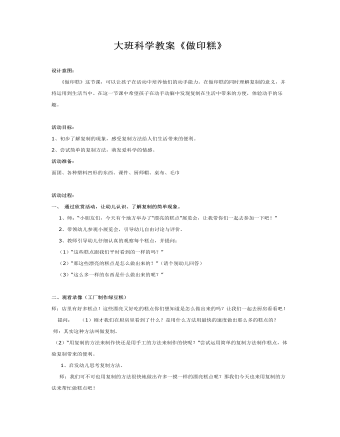
大班科学教案《做印糕》
活动目标:1、初步了解复制的现象,感受复制方法给人们生活带来的便利。 2、尝试简单的复制方法,萌发爱科学的情感。活动准备:面团、各种塑料凹形的东西、课件、厨师帽、桌布、毛巾 活动过程:一、通过欣赏活动,让幼儿认识、了解复制的简单现象。 1、师:“小朋友们,今天有个地方举办了“漂亮的糕点”展览会,让我带你们一起去参加一下吧!” 2、带领幼儿参观小展览会,引导幼儿自由讨论与评价。 3、教师引导幼儿仔细认真的观察每个糕点,并提问: (1)“这些糕点跟我们平时看到的一样的吗?” (2)“那这些漂亮的糕点是怎么做出来的?”(请个别幼儿回答) (3)“这么多一样的东西是什么做出来的呢?”
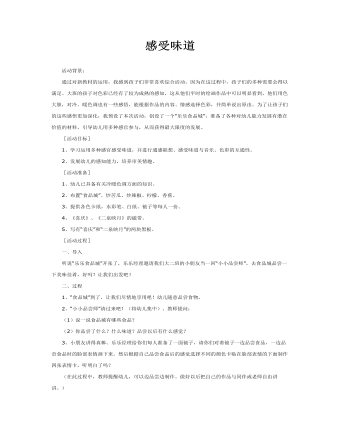
大班科学教案:感受味道
[活动目标]1、学习运用多种感官感受味道,并进行通感联想、感受味道与音乐、色彩的互通性。2、发展幼儿的感知能力,培养审美情趣。 [活动准备]1、幼儿已具备有关冷暖色调方面的知识。2、布置“食品城”。炒苦瓜、炒辣椒、柠檬、香蕉。3、提供各色卡纸,水彩笔、白纸、镜子等每人一份。4、《喜庆》、《二泉映月》的磁带。5、写有“喜庆”和“二泉映月”的两块黑板。 [活动过程]

新人教版高中英语必修3Unit 2 Morals and Virtues教学设计四
3.Teachers ask different groups to report the answers to the questions and ask them to try different sentence patterns.The teacher added some sentence patterns for students to refer to when writing.Step 4 Writing taskActivity 51.Write the first draft.Students first review the evaluation criteria in activity 5, and then independently complete the draft according to the outline of activity 4, the answers to the questions listed in the group discussion and report, and the reference sentence pattern.2.Change partners.The teacher guides the students to evaluate their partner's composition according to the checklist of activity 5 and proposes Suggestions for modification.3.Finalize the draft.Based on the peer evaluation, students revise their own compositions and determine the final draft.Finally, through group recommendation, the teacher selects excellent compositions for projection display or reading aloud in class, and gives comments and Suggestions.Step 5 Showing writingActivity 5T call some Ss to share their writing.Step 6 Homework1. Read the passage in this section to better understand the passage.2. Carefully understand the hierarchical structure of the article, and deeply understand the plot of the story according to the causes, process and results;3. Independently complete the relevant exercises in the guide plan.1、通过本节内容学习,学生是否理解和掌握阅读文本中的新词汇的意义与用法;2、通过本节内容学习,学生能否通过人物言行的对比分析道德故事的深层内涵;3、通过本节内容学习,学生能否根据故事的起因、经过和结果来深入理解故事的情节,从而了解文章的层次结构;4、结合现实生活案例发表自己的见解和看法,写一篇观点明确、层次分明的故事评论。

新人教版高中英语选修2Unit 3 Learning about Language教学设计
1. We'll need ten months at least to have the restaurant decorated.2.Some traditional Chinese dishes from before the Ming Dynasty are still popular today.3.My grandpa's breakfast mainly includes whole grain biscuits and a glass of milk.4.People in this area would eat nearly a kilo of cheese per week.5. We enjoyed a special dinner in a fancy restaurant where the waiters all wore attractive suits.6. He prefers this brand of coffee which, as he said, has an unusually good flavor.Key:1. at a minimum 2. prior to3. consist of4. consume5. elegant6. exceptionalStep 5:Familiarize yourself with some food idioms by matching the meaning on the right with the colored words on the left.1.Public concern for the health of farm animals has mushroomed in the UK2.Anderson may be young but he's certainly rolling to doing dough!3.George is a popular lecturer. He often peppers his speech with jokes.4.As the person to bring home the bacon, he needs to find a stable job.5 He is often regarded as a ham actor for his over emphasized facial expressions. The media reported that these companies had treated pollution as a hot potato. 6.The media reported that these companies had treated pollution as a hot potato.7.Don't worry about the test tomorrow. It's going to be a piece of cake!8. It's best to fold the swimming ring when it is as flat as a pancake.A. completely flatB. something that is very easy to do C.an issue that is hard to deal withD.to include large numbers of somethingE.to earn on e's living to support a familyF. wealthyG.to rapidly increase in numberH. an actor who performs badly, especially by over emphasizing emotions

新人教版高中英语选修2Unit 3 Using langauge-Listening教学设计
1. How is Hunan cuisine somewhat different from Sichuan cuisine?The heat in Sichuan cuisine comes from chilies and Sichuan peppercorns. Human cuisine is often hotter and the heat comes from just chilies.2.What are the reasons why Hunan people like spicy food?Because they are a bold people. But many Chinese people think that hot food helps them overcome the effects of rainy or wet weather.3.Why do so many people love steamed fish head covered with chilies?People love it because the meat is quite tender and there are very few small bones.4.Why does Tingting recommend bridge tofu instead of dry pot duck with golden buns?Because bridge tofu has a lighter taste.5 .Why is red braised pork the most famous dish?Because Chairman Mao was from Hunan, and this was his favorite food.Step 5: Instruct students to make a short presentation to the class about your choice. Use the example and useful phrases below to help them.? In groups of three, discuss what types of restaurant you would like to take a foreign visitor to, and why. Then take turns role-playing taking your foreign guest to the restaurant you have chosen. One of you should act as the foreign guest, one as the Chinese host, and one as the waiter or waitress. You may start like this:? EXAMPLE? A: I really love spicy food, so what dish would you recommend?? B: I suggest Mapo tofu.? A: Really ? what's that?

新人教版高中英语选修2Unit 4 Reading for writing教学设计
假定你是英国的Jack,打算来中国旅行,请你给你的中国笔友李华写一封信,要点如下:1.你的旅行计划:北京→泰山→杭州;2.征求建议并询问他是否愿意充当你的导游。注意:1.词数80左右(开头和结尾已给出,不计入总词数);2.可以适当增加细节,以使行文连贯。参考词汇:故宫 the Forbidden City;泰山 Mount TaiDear Li Hua,I'm glad to tell you that 'm going to visit China.First,I am planning to visit Beijing,the capitalof China,where I am looking forward to enjoying the Great Wall,the Forbidden City and somebeautiful parks.Then I intend to go to visit Mount Tai in Shandong Province.I've heard that it is one ofthe most famous mountains in China and I can't wait to enjoy the amazing sunrise there.After that,I amalso going to Hangzhou.It is said that it is a beautiful modern city with breathtaking natural sights,among which the West Lake is a well- known tourist attraction.What do you think of my travel plan? Will you act as my guide? Hope to hear from you soon.

新人教版高中英语选修2Unit 4 Using langauge-Listening教学设计
The theme of the listening section is " talking about scenery and culture along a journey."The part is designed to further lead the students to understand Canadian natural geography and social environment, and integrated into the cultural contrast by mentioning the long train journey from Beijing to Moscow routes. On this basis, the part activates students related travel experience, lets the student serial dialogue, guides the student to explore further the pleasure and meaning of the long journey, and Chinese and foreign cultural comparison.The part also provides a framework for the continuation of the dialogue, which is designed to provide a framework for students to successfully complete their oral expressions, and to incorporate an important trading strategy to end the dialogue naturally.1. Help students to understand and master some common English idioms in the context, and experience the expression effect of English idioms.2. Guide the students to understand the identity of different people in the listening context, and finish the dialogue according to their own experience.3. Instruct the students to use appropriate language to express surprise and curiosity about space and place in the dialogue, and master the oral strategy of ending the dialogue naturally.1. Instruct students to grasp the key information and important details of the dialogue.2. Instruct students to conduct a similar talk on the relevant topic.

新人教版高中英语选修2Unit 5 Learning about Language教学设计
The purpose of this section of vocabulary exercises is to consolidate the key words in the first part of the reading text, let the students write the words according to the English definition, and focus on the detection of the meaning and spelling of the new words. The teaching design includes use English definition to explain words, which is conducive to improving students' interest in vocabulary learning, cultivating their sense of English language and thinking in English, and making students willing to use this method to better grasp the meaning of words, expand their vocabulary, and improve their ability of vocabulary application. Besides, the design offers more context including sentences and short passage for students to practice words flexibly.1. Guide students to understand and consolidate the meaning and usage of the vocabulary in the context, 2. Guide the students to use the unit topic vocabulary in a richer context3. Let the students sort out and accumulate the accumulated vocabulary, establishes the semantic connection between the vocabulary,4. Enable students to understand and master the vocabulary more effectivelyGuiding the Ss to use unit topic words and the sentence patterns in a richer context.Step1: Read the passage about chemical burns and fill in the blanks with the correct forms of the words in the box.

新人教版高中英语选修2Unit 5 Reading and thinking教学设计
The theme of this activity is to learn the first aid knowledge of burns. Burns is common in life, but there are some misunderstandings in manual treatment. This activity provides students with correct first aid methods, so as not to take them for granted in an emergency. This section guides students to analyze the causes of scald and help students avoid such things. From the perspective of text structure and collaborative features, the text is expository. Expository, with explanation as the main way of expression, transmits knowledge and information to readers by analyzing concepts and elaborating examples. This text arranges the information in logical order, clearly presents three parts of the content through the subtitle, accurately describes the causes, types, characteristics and first aid measures of burns, and some paragraphs use topic sentences to summarize the main idea, and the level is very clear.1. Guide students to understand the causes, types, characteristics and first aid methods of burns, through reading2. Enhance students’ ability to deal withburnss and their awareness of burns prevention3. Enable students to improve the ability to judge the types of texts accurately and to master the characteristics and writing techniques of expository texts.Guide students to understand the causes, types, characteristics and first aid methods of burns, through readingStep1: Lead in by discussing the related topic:1. What first-aid techniques do you know of ?CPR; mouth to mouth artificial respiration; the Heimlich Manoeuvre

新人教版高中英语必修3Unit 2 Morals and Virtues教学设计三
The joke set her crying.这个玩笑使她哭起来。Step 5 ReadingActivity 31. Students read the small text in activity 3. The teacher provides several small questions to check whether students understand the content of the text and the ideographic function of the -ing form in the text.*Where are those people?*Why did Dr Bethune come to China?*How did he help the Chinese people during the war?*What did Chairman Mao Zedong say about him?2. Ss try to rewrite some sentences using the -ing form. Then check the answers. When checking the answers, the teacher can ask different students to read the rewritten sentences and give comments.Answers:1. he became very interested in medicine, deciding to become a doctor.2. …after hearing that many people were dying in the war.3. Helping to organise hospitals, he taught doctors and nurses, and showed people how to give first aid./ He helped to organise hospitals, teaching doctors and nurses, and showing people how to give first aid.4. …praising Dr Bethune as a hero to be remembered in China.Step 6 PracticeActivity 4Students complete grammar activities 2 and 3 on page 69 of the workbook.Step 6 Homework1. Understand and master the functions and usage of the -ing form;2. Finish the other exercises in Using structures.1、通过本节内容学习,学生是否理解和掌握动词-ing形式作宾语补足语语和状语语的功能和意义;2、通过本节内容学习,学生能否正确使用动词-ing形式描述人物的行为、动作及其经历;3、通过本节内容学习,学生能否独立完成练习册和导学案中的相关练习。

